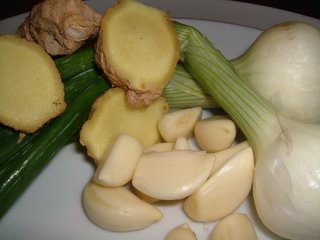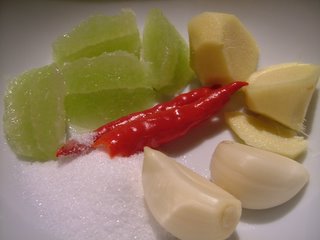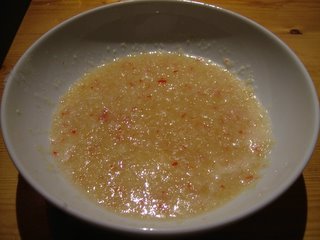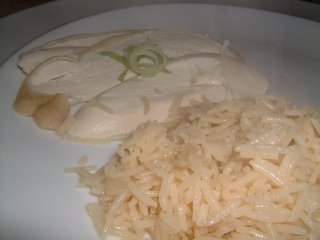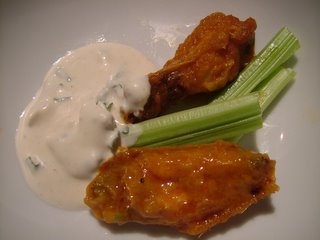 Another item from the Great American Suitcase Load of Food I brought back last February was a large bottle of Frank’s Hot Sauce. Frank’s is the traditional sauce used for gorgeous, buttery, spicy Buffalo wings; unfortunately it’s hard to find the dish or the sauce readily in the UK, so you’ll have to resort to importing sauce and making your own wings.
Another item from the Great American Suitcase Load of Food I brought back last February was a large bottle of Frank’s Hot Sauce. Frank’s is the traditional sauce used for gorgeous, buttery, spicy Buffalo wings; unfortunately it’s hard to find the dish or the sauce readily in the UK, so you’ll have to resort to importing sauce and making your own wings.
We’re in luck; chicken wings, being bony and a little unprepossessing, are not something the English, who seem to prefer meat that comes in boneless, skinless chunks, buy very often. While they’re usually available in the shops, they’re not expensive. This is great news for me; there are plenty of excellent Chinese chicken wing recipes (when I was little we’d fight over the wings, which my Dad always assured us were where the very tastiest, most succulent meat was), and I have an artery-clagging love for Buffalo wings with blue cheese dip and celery. I decided to break into my bottle of Frank’s, and pay no attention to the calories.
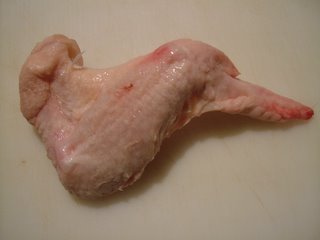 You’ll need to joint your chicken wings. It’s extremely easy; you just need a sharp knife. This wing is whole – spread it out and look for the two joints. Mr Weasel, taller, stronger and kinder than me, suggested that his extra height would make the jointing easier. Shamefully, I stood back, beaming, and let him do it. I really don’t enjoy handling raw chicken very much; I’m usually fine with raw meats, but for some reason I find chicken a bit difficult. There’s something about the way it smells raw which makes me enjoy the cooked product less. Poor thing; he does work for his supper. The joints themselves are softer than the bone itself, so your knife should penetrate cleanly and neatly.
You’ll need to joint your chicken wings. It’s extremely easy; you just need a sharp knife. This wing is whole – spread it out and look for the two joints. Mr Weasel, taller, stronger and kinder than me, suggested that his extra height would make the jointing easier. Shamefully, I stood back, beaming, and let him do it. I really don’t enjoy handling raw chicken very much; I’m usually fine with raw meats, but for some reason I find chicken a bit difficult. There’s something about the way it smells raw which makes me enjoy the cooked product less. Poor thing; he does work for his supper. The joints themselves are softer than the bone itself, so your knife should penetrate cleanly and neatly.
 Chop through both joints like this, and discard the wing tip. You’ll end up with a little drumstick-looking bit, and one with two little bones (much like your forearm, if you, like me, can only remember which bits of meat are where on an animal by comparing the animal with yourself).
Chop through both joints like this, and discard the wing tip. You’ll end up with a little drumstick-looking bit, and one with two little bones (much like your forearm, if you, like me, can only remember which bits of meat are where on an animal by comparing the animal with yourself).
Heat deep oil for frying to 190c (375f). I use a wok and a jam thermometer for deep frying; the wok means you use less oil, and having a wide container means you can fry more wings at once. Fry the winglets in batches ( I did six at a time) until they are golden brown.
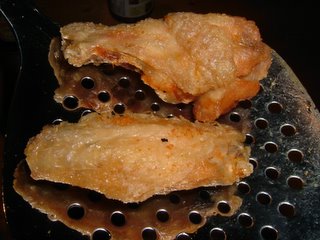 When one batch of wings is ready (they should be about this colour), put them to drain on some kitchen paper in a very low oven, where they can keep warm until all their friends are ready. I cooked fifteen wings (so thirty chopped up wing bits), which should serve three people.
When one batch of wings is ready (they should be about this colour), put them to drain on some kitchen paper in a very low oven, where they can keep warm until all their friends are ready. I cooked fifteen wings (so thirty chopped up wing bits), which should serve three people.
Meanwhile, you can get to work on the blue cheese dip while your sous chef gets on with cutting celery into strips. I used a recipe given to me by an American friend, which I’ve further messed about with and added to a bit; I think it’s pretty much perfect:
1 cup sour cream
1 cup mayonnaise
1/2 cup crumbled blue cheese (use the strongest cheese you can find; for me, this time round it was Gorgonzola, but Roquefort’s great in this too)
1 tablespoon cider vinegar
2 tablespoons lemon juice
1 grated shallot
1 clove grated garlic
1 handful fresh herbs, chopped finely (I used parsley and chives)
2 teaspoons Chipotle Tabasco sauce (use regular Tabasco if you can’t get the lovely smokey Chipotle version)
Salt and pepper to taste.
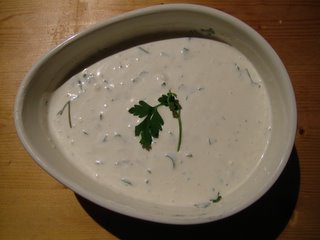 Easy as pie; just mix the lot up together.
Easy as pie; just mix the lot up together.
Now warm half a bottle of that Frank’s hot sauce, transported across continents wrapped in your knickers like precious jewellery, with half a pat of butter. When the butter is melted, whisk it all together. Pour the lot over the crispy little winglets in a deep bowl, and toss like a divine salad.
Serve with the blue cheese dip and the sticks of celery. You’ll make a terrible mess; have lots of napkins on the table.
I really must find out who the hell this Frank fellow with the sauce is, find him and shake his hand.

